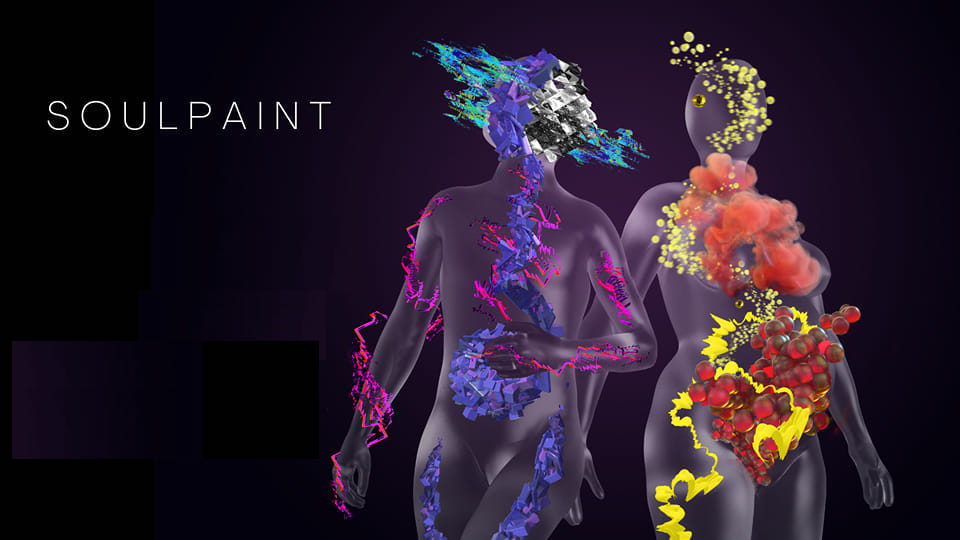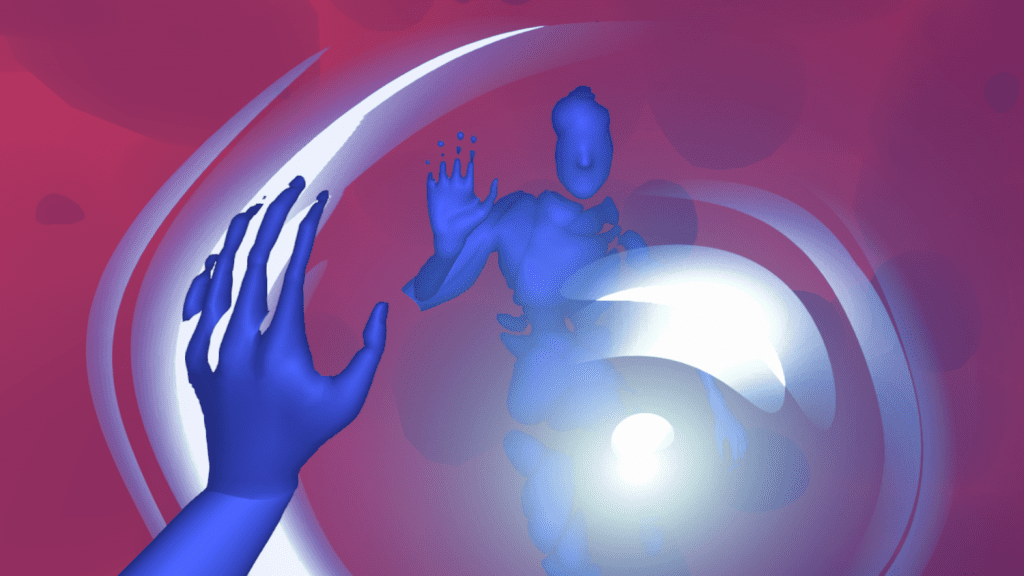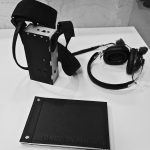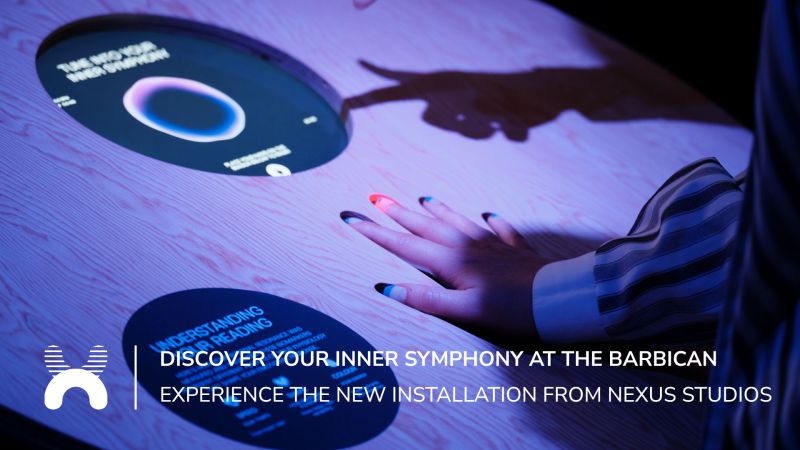WELLNESS SERIES: CLARITY
by Natalie Smithson
Feat. Sarah Ticho’s Soul Paint VR experience, Duncan Speakman’s Only Expansion audio tour, and Kinda Studios explorations into brain waves and art.

It might seem at odds with instinct and intellect to use technology to uncover the complex, intangible workings of your inner self, yet an investigative wave of technologists are proving otherwise. Their work shows a smart mix of art and science can help you get to know yourself better by revealing what’s going on under the surface.
Get to know how you operate on a deeper level and you can be clear on what brings you happiness, excitement, or comfort. You’ll make better choices on who you spend time with, the work you will or won’t do, and on activities you do in your spare time. The problem is, getting to know yourself is harder than it might seem.
What we see from those in the wellness space is the use of technology can help open up parts of ourselves that are otherwise difficult to reach. Since we can’t see our brain function, we can only detect through our emotions when it’s off or not working. We might know how well we feel or don’t feel, but it’s hard to detangle those emotions to seek any help we might need.
What clever use of technology teaches us is you can visualise and, so, examine what you’re feeling, begin to understand what triggers good or bad moods, and tap into your innermost workings as a unique human to notice more intently what you need to feel good.
Release how you feel in colour bursts with VR
Stepping into a VR headset, taking a games controller in each hand, and seeing yourself embodied in a vibrant, swirling digital existence moves you into a space of control. This is what happens when you take part in the VR experience, Soul Paint, from Hatsumi agency.

Isolated from the rest of the world for a short time, you’re given a virtual brush and set of colours to express what you feel and where you feel it, looking at your own virtual body in a freshly painted skin. It’s an opportunity to translate pain and emotion into a visual representation.
You might feel angry and choose red to paint a sharp squiggle where your heart is, or blue dots to highlight pain in infected kidneys, but red won’t be the colour of anger for everyone, nor is blue always representative of a negative experience. What matters is the controls sit in your hands directly, ready to help you express what you’re feeling in a way that makes sense to you.
Painting with VR onto a virtual reflection of your living self is a grounding experience. You can feel the arch of your feet on the ground and the click of the controller against the skin of your fingers. Your shoulder movements are as vivid as the colours you see, and so the real you and the virtual you quickly become one.
Slowly, you can start to focus on giving your feelings a colour and also a texture, with a choice of different brush types to make your marks. Huge sweeping bursts of blob-like colour, or spindly scratches of forced dark shapes. You go with whatever you’re drawn to in the moment.


Images from soulpaint.co
Enter a virtual world for a clearer focus on you
Seeing your feelings drawn out in this way means you’ve not only inspected how you’re feeling and where pain sits, you can also study the portrait you’ve produced at the end. You’ll know if what you see looks good to you or not, seeing yourself with objective clarity.
The pilot study for Soul Paint drew in people unfamiliar with VR by letting them try the technology in a community space that was both comfortable and accessible: a library just outside of London. With the promise of imperfection and a small reward for feedback, coupled with striking visuals from inside the system and a clear outline of what they hoped to achieve, Soul Paint has grown into an award-winning experience, recognised for innovation by 10 Downing Street as part of the 2025 London Tech Week.
“To be able to be in touch with myself, articulate it visually, and then watch it back and interact with myself was a really good way of ending my day and letting it go” says one woman who tried Soul Paint at the end of a difficult day.
Having a virtual space to disconnect from the outside world directly gifts you the chance to check in with yourself, providing a space for clear focus that’s sought after and yet hard to find in a busy world.
Reignite your senses by stepping in between worlds
It’s common for your own sense of self to be drowned out by people around you and bustling places. Walking around a city, you might be completely unaware at times of what you’re thinking or feeling. Other sounds, chatter, and activity demands your attention, but Duncan Speakman’s Only Expansion audio tour brings you back to the forefront.
With a compact metal box hanging across your body like a shoulder bag and an on/off switch falling at your hip, you wear headphones and hold a thin yet sturdy booklet in your hands. You’re invited to turn the pages along the walk which, for me, starts at the harbourside in Bristol at the immersive gallery, Undershed.

As you walk, audio fills your consciousness and the words in the booklet ask you to observe what’s around you. In a weird twist of reality, children playing on the steps by the water are suddenly sliding down the low walls in slow motion. I can’t hear them now. I only see their mouths moving as smiles form and, clearly, they shout across to others. Surreal and dreamlike, whatever you see in front of you slips slightly outside your existence.
With isolated focus comes hyper-sensitivity
The tour takes you out into the city, but you choose where to go. ‘Find a quiet place’ is one of the instructions but it’s your call how that space is defined. This leaves you largely free to focus on everything you’re experiencing, both physically and emotionally, inside your body as you walk.

You turn each page when a voice in your ear prompts it and the audio changes too. At one point, I’m asked to imagine an hour or month passes by every time I take a step forward. The beat of electronic music becomes urgent and my heartbeat rises as I walk past a building with pillar after pillar curling around a long line of windows. Bending around a corner by the roadside, I figure at least a day, if not a year, has passed and it’s a vivid reminder of how precious our time is.
Crossing the road, I look back to see a man carrying flowers and the colours burst with the audio, turning everything else in sight grey.
Towards the end of the tour, I’m asked to observe the place where I first started walking and I watch a boat turn in the harbour. On a smaller vessel, a rotating bird scarer spins around at accelerated speed. Every movement is heightened and I see all the individual leaves on trees blowing in the wind. Passers-by merge into a giant sea of people, moving in tides, and everything I’d ordinarily hear, and expect to hear, is gone.
All I’m left with is myself.
When the audio ends, time slows back down. People are mumbling and shuffling and the air is stiff.
Colours dull down and I immediately disengage, thinking how vivid life had been just moments before. Cutting myself off while still somehow being present disturbs how I choose to see the world from here; how things can be if I’m guided less by spaces and more by senses.
Using your body as an antennae for wellness
Luke Kemp, head of creative programming at Barbican Immersive says “sound is more than an audio experience. We can think of our whole body as a listening device”.
Today, immersive technicians use that approach to help people tap into what’s happening inside their body, so they can respond in a way that improves wellbeing, be it physical or mental health.
London’s Kinda Studios uses a fine blend of art and science to examine the theory of things like interoception, described by The Guardian as “the hidden sense that shapes wellbeing“. Say your heart is racing because you’re afraid, or you’re falling in love, or your palms are sweaty because you’re nervous, or perhaps excited. The goal is to expose externally what’s going on inside, and in a creative way, so anyone can interact with their work and better understand themselves and feel well.
In collaboration with Nexus Studios, Kinda Studios is part of the Feel the Sound exhibition at the Barbican. They’re tracking the heart rates of visitors at the event, including any ups and downs, and how much they sweat. To take part, you simply put your hand onto a pad, which then gathers and includes your data in the research. It shows you visually what you’re experiencing as you hear different sounds and feel a range of vibrations throughout the exhibition.

“Scientists have shown that our sensitivity to interoceptive signals can determine our capacity to regulate our emotions, and our subsequent susceptibility to mental health problems such as anxiety and depression,” says David Robson for The Guardian.
Anticipating and protecting your emotional response
As part of their ongoing research, the team at Kinda Studios use EEG headsets and biosensors to detect and measure brainwaves. This can detect sensations people may or may not be aware they’re feeling, and in doing this, they can go on to create experiences to sooth and support them. Past projects include everything from breathwork and reducing anxiety to boosting your energy while you’re keeping fit and running:
“Sound is one of our most powerful aesthetic drivers to arouse emotion, shift our mood and motivate us into action. By working with specific properties of sound like BPMs, frequencies, rhythmic dynamics and build up and release, we can trigger specific brain and body states to release a flood of feel-good neurochemicals and physiological reactions that create lasting changes on mood – a fundamental component of energy and motivation that is vital to performance at all levels.” ― Kinda Studios
Blending immersive arts and science brings clarity to help us thrive
Virtual worlds away from the hustle and bustle, audio cocoons, and seeing visually how you’re feeling opens up our mysterious inner world.
Experimenting with emerging tech in this way helps people find clarity for thoughts and feelings as well as physical and mental pain. It’s especially helpful where traditional support structures can fail.
Knowing where it hurts, isolating your feelings, and listening in closely to your own spidery senses can help us recognise what we need as individuals to improve our own wellbeing and live better, as we like it.







